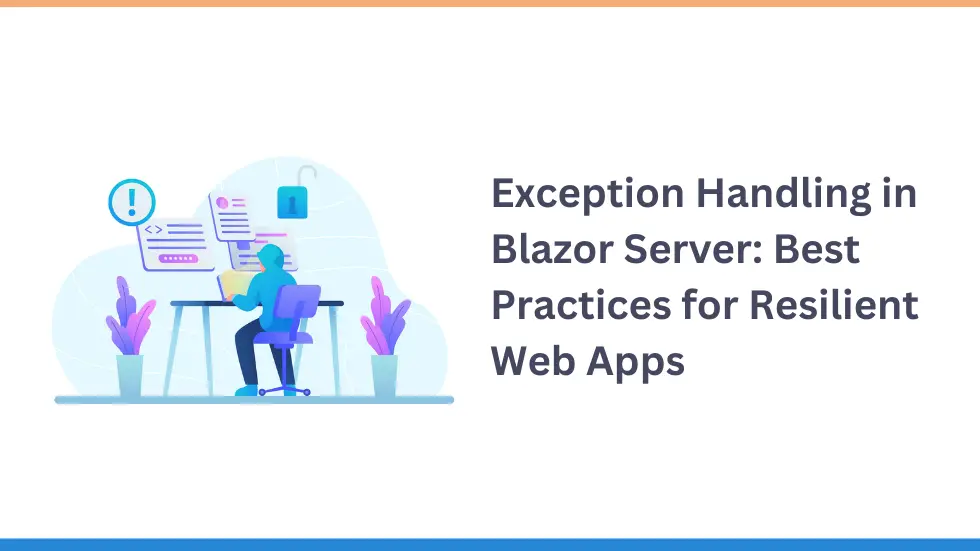In modern web development, delivering a reliable and resilient user experience is crucial—especially for enterprise-grade applications.
With Exception Handling in Blazor Server, Microsoft introduces a powerful model that connects the client and server via SignalR, enabling real-time web applications using .NET. However, this persistent connection also introduces unique challenges in managing exceptions effectively.
This blog explores the lifecycle of exceptions in Blazor Server, identifies common pitfalls, and offers practical strategies to implement robust error handling—ensuring app stability and improved user trust.
Understanding the Exception Lifecycle in Blazor Server
In a Blazor Server application, user interactions on the frontend are tightly coupled with backend operations via SignalR. This means that exceptions can occur anywhere in the chain—from UI events to API calls.
Exception Flow Overview:
pgsql
CopyEdit
User Action ➜ UI Event ➜ Component Code ➜ Service Layer ➜ API/Database ➜ Exception ➜ Logging ➜ UI Feedback
Every exception that occurs in this flow must be caught and handled server-side to prevent application crashes or connection drops.
Common Technical Pitfalls in Blazor Error Handling
1. Not Catching Exceptions in Async Methods
Neglecting to use try-catch in asynchronous methods can cause app crashes or unexpected behavior.
Poor Implementation:
csharp
CopyEdit
private async Task LoadData()
{
var result = await dataService.GetDataAsync(); // App crashes if this fails
}
Proper Implementation:
csharp
CopyEdit
private async Task LoadData()
{
try
{
var result = await dataService.GetDataAsync();
}
catch (Exception ex)
{
logger.LogError(ex, “Error loading data.”);
errorMessage = “Failed to load data.”;
}
}
2. UI Doesn’t Recover Gracefully After an Error
If errors occur during rendering, users may see a broken screen or lose functionality.
Solution: Wrap rendering logic to ensure graceful fallback.
razor
CopyEdit
@if (hasError)
{
<div class=”alert alert-danger”>Something went wrong.</div>
}
else
{
<MyComponent />
}
3. Missing Centralized Error Handling
Handling exceptions in each component can lead to scattered and inconsistent behavior.
Solution: Use the built-in ErrorBoundary component in .NET 7+ to isolate and manage errors effectively.
razor
CopyEdit
<ErrorBoundary>
<ChildContent>
<MyComponent />
</ChildContent>
<ErrorContent>
<p>Oops! Something broke.</p>
</ErrorContent>
</ErrorBoundary>
Real-World Issue: Unhandled Exceptions Can Break SignalR Connection
In Blazor Server, an unhandled exception may crash the SignalR circuit, leading to lost connections and requiring the user to refresh manually—potentially causing data loss.
Recommended Approach: Track Circuit Lifecycle with CircuitHandler
csharp
CopyEdit
public class ErrorTrackingCircuitHandler : CircuitHandler
{
private readonly ILogger<ErrorTrackingCircuitHandler> logger;
public ErrorTrackingCircuitHandler(ILogger<ErrorTrackingCircuitHandler> logger)
{
this.logger = logger;
}
public override Task OnCircuitClosedAsync(Circuit circuit, CancellationToken cancellationToken)
{
logger.LogWarning(“Circuit closed: {Id}”, circuit.Id);
return base.OnCircuitClosedAsync(cancellationToken);
}
}
Register in Program.cs:
csharp
CopyEdit
builder.Services.AddScoped<CircuitHandler, ErrorTrackingCircuitHandler>();
Best Practices for Exception Handling in Blazor Server
To ensure your application is resilient and production-ready, adopt the following practices:
- ✅ Always wrap async methods with try-catch
- ✅ Display user-friendly error messages
- ✅ Use structured logging for traceability
- ✅ Use ErrorBoundary for UI exception containment
- ✅ Create a reusable error service to standardize responses
- ✅ Monitor disconnections using CircuitHandler
Advanced Tip: Retry Logic for Transient Failures
Add retry mechanisms for operations that may fail temporarily (e.g., network calls).
csharp
CopyEdit
public async Task<T?> TryExecuteWithRetry<T>(Func<Task<T>> action, int retries = 3)
{
int attempt = 0;
while (attempt < retries)
{
try
{
return await action();
}
catch (Exception ex)
{
logger.LogWarning(ex, $”Attempt {attempt + 1} failed.”);
attempt++;
await Task.Delay(500);
}
}
logger.LogError(“All retry attempts failed.”);
return default;
}
Conclusion
Mastering exception handling in Blazor Server is essential for delivering stable, scalable, and secure applications.
From handling async method failures and using ErrorBoundary, to tracking circuit disconnections and retrying failed operations—these strategies not only prevent crashes but also build trust with users.
For enterprise businesses and startups developing critical applications with Blazor, investing in proper exception management is not optional—it’s a necessity.
Additional Resources:
